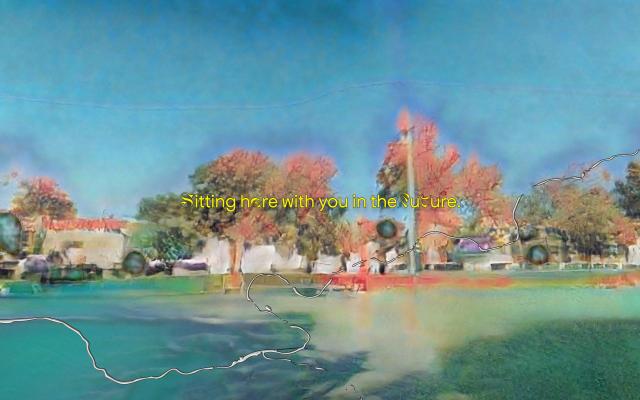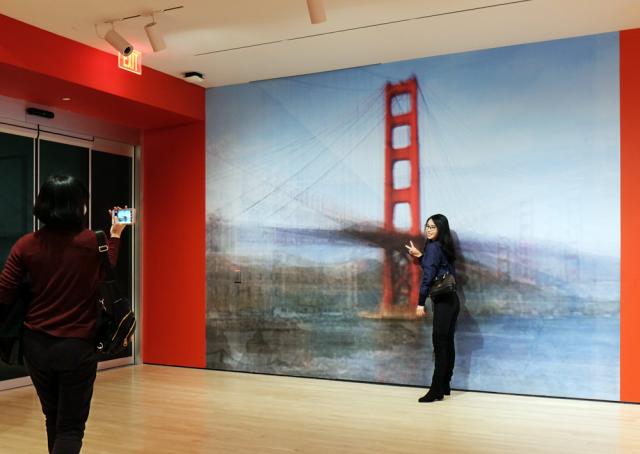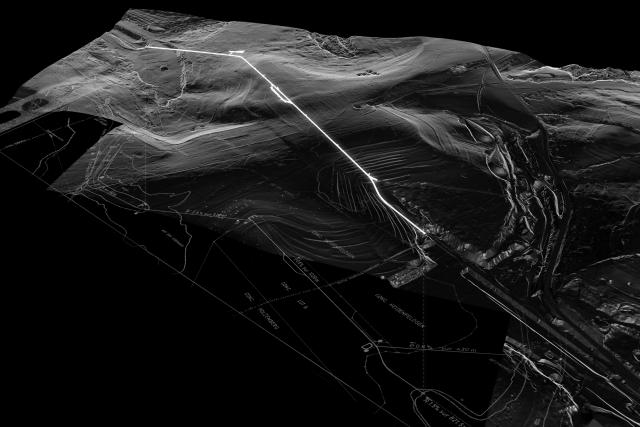This event is ended. Thank you all for your participation!
Cyber Structures: Material Realities–Digital Experiences

Elektron
Elektron is a unique artistic platform combining the arts and digital technologies in Esch-sur-Alzette, Luxembourg's second largest city. Through exhibitions, public art installations and events, Elektron is a must-see programme for art enthusiasts, digital specialists, and curious minds alike.
The goal? To offer keys to understanding while questioning the effects of digital technologies on our daily lives and our environment.
Cyber Structures: Material Realities – Digital Experiences
Cyber Structures: Material Realities – Digital Experiences
For its launch in May 2024, Elektron invites you to discover the hidden side of the digital world. A series of artworks and exhibitions spread throughout the city-centre of Esch-sur-Alzette, to better understand the impact and implications of the invisible infrastructures governing the digital world.
Data centres, underground cables, intercontinental submarine cables, antennas and satellites make up this decentralised and interconnected infrastructure, which functions like a network of networks. Paradoxically, its omnipresence in our lives often makes us forget the ecological, political, cultural, and social issues linked to its deployment and use.
In 2024 Elektron explores this paradox through seven exhibition projects and artworks presented as part of an urban itinerary. Linking key locations in the town centre of Esch-sur-Alzette, Cyber Structures: Material Realities – Digital Experiences provides an opportunity to discover and better understand the ecological, political, and social implications of this infrastructure through art.
Presented in both indoor and outdoor spaces, the installations address key issues such as: How does the artistic use of technology allow us to see the impact of human activities on the planet in a new and disruptive way? What forms do surveillance and digital colonialism take around the world? How do the Internet and social networks contribute to the creation of communities and a collective visual memory?
These questions are addressed in the installations across town. They are explored in greater depth and linked to the specific context of Esch-sur-Alzette and the Greater Region through meetings and workshops with Luxembourgish and international experts. This rich public programme reflects Elektron's ambition to become the reference platform for art, digital technology, science and social issues in the Greater Region.
Parcours urbain

Dates: 18.05.2024 > 01.09.2024
Location: Konschthal
FRAMERATE: Pulse of the Earth bears witness to landscapes in flux. The work reveals alterations caused by human-centred industry and the immense forces of nature: destruction, extraction, habitation, construction, harvests, growth, and erosion.
Created from thousands of daily 3D timelapse scans of natural and man-made landscapes, the work observes change on a scale impossible to see with the lens of traditional cameras.
FRAMERATE: Pulse of the Earth invites you to observe in another way. To think and feel in another time scale: geological time, seasonal time, tidal time. To contemplate change, and the pace of change. This is a space where your perspective might shift. This is not just an artwork. The data collected and presented by FRAMERATE is ground-breaking scientific research containing empirical, measurable facts.

Dates: 18.05.2024 > 01.09.2024
Location: Konschthal
The Internet and its services rely on infrastructures that span the entire planet: undersea cables, data centres, antennas, satellites... The exhibition FUTURE_FORECAST by Ziyang Wu + Mark Ramos explores these infrastructures and imagines the future of our connected societies from a non-western perspective.
The complex political, economic social, and ecological environment of the Philippines sets the framework for the two works presented in the exhibition. The video Pasig River 2030 - 6 Plus and the playable simulation Future_Forecast question the complex relationship between technological progress, emerging markets, traditional cultures and digital colonialism.
The Pasig River 2030 - 6 Plus video takes us to the Philippines in 2030 on the banks of the Pasig River, which runs through metropolitan Manila. It tells the story of the collaboration between Alihaha, a fictional telecommunications giant and BOT.coin, a blockchain company, together with the Philippine government. Although declared “ecologically dead” in the early 2000s due to pollution, the Pasig River in the video has been revitalized thanks to the joint technological initiatives of these private companies and the government. However, many problems remain. These relate to the surveillance and digital colonisation of the river and the city. With humor and irony, Pasig River 2030 - 6 Plus reveals the contradictions between digital strategies and material reality.
Future_Forecast is a real-time simulation, a game of collective universe-building and a series of characters. It invites players to measure the paradoxical ecological, geopolitical and socio-cultural consequences of their actions through six missions in 6 different spaces. Inspired by Benjamin H. Bratton's Stack theory, Future_Forecast envisions our complex interconnected world as a stack of six interconnected strata: Earth stratum, Cloud stratum, City stratum, Address stratum, Interface stratum, User stratum. By exploring these strata and the cause-and-effect relationships of their actions with the various constituent elements of these environments, Future_Forecast players can act to mitigate the harmful effects linked to the development of digital technology and its infrastructures, such as: toxic gas emissions from data centers, ecological destruction, the prosperity of the dark web and accelerated surveillance by the Internet of Things.

Dates: 18.05.2024 > 13.07.2024
Location: 120 rue de l'Alzette
The installation Connecting the Dots consists of two hundred and seventy-nine connecting the-dots-drawings representing transcontinental submarine cables, the infrastructure that carries ninety-nine percent of intercontinental Internet traffic. The drawings were made by children aged between four and six, individuals still lacking the conceptual framework to grasp the significance of what they were drawing.
Whereas psychologists use these drawings to study children’s cognitive development, in Connecting the Dots they aim to show how the presence and use of the Internet will influence this development. A captivating reflection on how this young generation, for whom the Internet will be as familiar as tap water, perceives, and shapes the digital world around them.

Dates: 18.05.2024 > 01.09.2024
Location: 10, 19, 90, 91 Rue de l'Alzette
QT.bot is an artificial intelligence, trained on the textual and visual data of the community mapping platform Queering the Map, that generates speculative queer and trans futures and the environments in which they occur. Their digital mind is constructed from an implementation of the Open AI GPT-2 text generation model trained on over 82 000 text entries from the platform, and a StyleGAN trained on scraped Google Street View imagery of the tagged coordinates on Queering the Map.
The experience of viewing the machinic narratives and environments of LGBTQ2IA+ life that QT.bot propagates is one of disorientation –time, space, and subjectivity collapse, producing multiplicitous visions of the many futures contained within the data. In collaboration with the voices of their human community, QT.bot fabulates on the absences of the archive, orienting us away from what is, and towards what could be.

Dates: 18.05.2024 > 29.09.2024
Location: Centre Mercure
We travel, we visit iconic monuments and landscapes, we take a picture, and we publish our images on the Internet. The sheer volume of photos produced and distributed this way testifies to our desire to be elsewhere, and its intimate relation to image-making. It also illustrates how photographs shape our understanding and our knowledge of places and geographies.
Franco-Swiss artist Corinne Vionnet is a pioneer in the exploration of web-based imagery. As early as 2004, she realized that the photos we take of major tourist landmarks are so similar as to blend into one another. How is this possible? Consciously or unconsciously, we reproduce existing visual clichés of these places, inspired by images we saw even before discovering the sites, on postcards, at the movies or on social networks.
Starting from this premise, Corinne Vionnet conducted extensive online research into the world's most visited tourist sites and the images circulating about them on the web. She asked herself how we encounter a monument or a place with our digital cameras and smartphones. What point of view do we choose? Which aspects of the place do we include in the image, and which are the ones we edit out?
Photo Opportunities is the result of this extensive work based on images found on the Internet, re-appropriated, and meticulously compiled by the hundreds to build complex, spellbinding works.

Dates: 18.05.2024 > 28.09.2024
Location: Bridderhaus
We are stepping into the field of transformation. We follow the path through liquefying binarities and encounter the ambiguity of signs within the foggy data clouds. We listen to the waves of fluid codes and start digitalizing the threshold.
Datamorphosis is an exhibition on the blurry, disorienting space between input and output based on artistic research, an exploration of digital black boxes. A stage for prototypes, experiments, and discussions.
Participating artists: Salma Aly, Alex Fallica, Simon Hehl, Martina Pizzigoni, Sofia Talanti, Emma Silvana Tripaldi
Mentor: Univ. Prof. Mag.a Manuela Naveau, PhD

Dates: 18.05.2024 > 28.09.2024
Location: Bridderhaus
During the industrial era, a vast network of tunnels and mines was dug deep underground, criss-crossing the Terres Rouges from end to end, on several levels, even crossing the border, to link factories and steel production sites. Today, access to these underground passages is closed. Trees and shrubs hide the entrances; nature has reclaimed its rights in this landscape shaped by humans. The mining infrastructure beneath our feet, which has become obsolete over time, is less and less visible, until it disappears from our imagination.
The ARBED tunnel between Rumelange (Laangegronn) and Esch-sur-Alzette (Burbacherlach) is no exception. Originally used as an ore transport route, it later housed a local analog TV antenna cable. Since the switch to digital, the tunnel's function as a transport vessel has been discontinued. "Useless" and abandoned, it continues nevertheless to attract the interest of urbex enthusiasts keen on clandestine mining exploration and is home to several species of bats.
For artist Serge Ecker, the ARBED tunnel embodies the rich and complex overlay of the region's industrial history and its transformation into the digital age. The different strata of history, sociology, ecology, and geology come together in the work Passages, which he created for Elektron's inaugural exhibition CYBER STRUCTURES: Material Realities - Digital Experiences.
Using 3D scanning technologies, Serge Ecker was able to capture the entire 1,800-meter-long tunnel. The data collected in this way forms the basis for creating a 3D-printed sculpture. However, the use of these technologies is part of an approach that goes beyond the simple visual preservation of the tunnel. They also allow us to bear witness to the evolution of this space over time, reintegrating it into our collective memory.

Dates: 27.09.2024 > 06.10.2024
Location: 83-91 Rue de l'Alzette
KORRELATION is an interactive projection that transforms a portion of rue de l’Alzette into an abstract aquatic and scientific landscape that responds to the steps of passers-by.
The work reveals the Alzette that flows hidden beneath street level, making visible the river that gives its name to the town of Esch-sur-Alzette. The Alzette springs near Thil in France, crosses through Esch largely underground, before reaching Luxembourg City, Mersch, and Ettelbruck, where it flows into the Sûre.
KORRELATION reminds us that water is our most precious resource and draws our attention to the close relationship between humans, nature, and technology.
